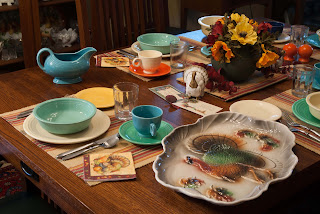 |
| My Father |
 |
| My Mother: At 1st sewing machine on left, facing camera |
In 1871, Homer and Shakespeare Laughlin, two brothers, formed a partnership selling pottery that was made in East Liverpool, England. But by 1870, public tastes were changing from yellow ware to a more sophisticated white ware. The Liverpool City Council offered money to build and operate a factory to make white ware. The two brothers submitted a proposal which was accepted, and a plant was built in 1873 on the banks of the Ohio River. The plant flourished, but Shakespeare Laughlin moved to California and Homer Laughlin continued the pottery production as the Homer Laughlin China Works. During the 1880 the company became well known for it ceramic dinnerware.
 Frederick Rhead was hired as designer in 1927 and he became famous for his Fiesta dinnerware design. With Fiesta sales soaring, The Homer Laughlin China Company continued to flourish until the beginning of World War II when production shifted to making military ware. When the war ended, the plant once again began production of Fiesta dinnerware producing over ten million dozen pieces in 1948.
Frederick Rhead was hired as designer in 1927 and he became famous for his Fiesta dinnerware design. With Fiesta sales soaring, The Homer Laughlin China Company continued to flourish until the beginning of World War II when production shifted to making military ware. When the war ended, the plant once again began production of Fiesta dinnerware producing over ten million dozen pieces in 1948.
In the sixties my mother got rid of all of her orange Fiesta because news reports at the time said the orange Fiesta was radioactive. I looked into this and found that from 1936 until 1942 the glaze that was used to produce the red-orange color contained both uranium and lead. During World War II the use of uranium was discontinued and controlled by the government. Vintage red-orange items are radioactive but the radiation given off is very low. It was determined that it is safe to eat from these pieces, but food should not be stored in them or they should not be used in a microwave.
By 1950, foreign competition hurt the American pottery industry and The Homer Laughlin China Company shifted production to hotel dinnerware. The company survived during the difficult sixties and seventies producing china for the food service industry. By 1980’s, the company changed and started using lead-free glazes and vitrified china. They reintroduced Fiesta in new colors. Today both the old and the new Fiesta continue to be popular dinnerware in American homes.
Eventually my mother gave some of the pieces of Fiesta away and packed up the rest. It wasn't until after my daughter got married that the Fiesta reappeared. They fit nicely into her Arts and Craft style home and she enjoys using the dishes for their bright colors and cheery look. Her grandmother would be pleased.


